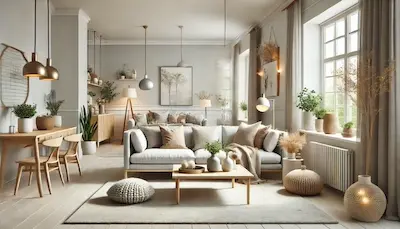Scandinavian living rooms are celebrated for their minimalist aesthetics, functionality, and cozy ambiance. Rooted in the design traditions of Denmark, Sweden, Norway, and Finland, this style emphasizes simplicity, natural materials, and a harmonious balance between form and function.
History and Origins of Scandinavian Living Room Design
Emerging in the early 20th century, Scandinavian design gained prominence post-World War II. Influenced by the German Bauhaus movement, designers like Kaare Klint in Denmark began creating furniture with clean lines and functional forms, focusing on high-quality craftsmanship and materials. This approach laid the foundation for what became known as Danish Modern, a significant component of Scandinavian design.
The harsh Nordic climate, characterized by long, dark winters, also played a crucial role in shaping this design ethos. Interiors were designed to maximize light and create a cozy atmosphere, leading to the use of light color palettes, natural materials, and open, uncluttered spaces.
Key Features of Scandinavian Living Rooms
- Neutral Color Palettes: Predominantly whites, grays, and soft pastels to enhance natural light and create a serene environment.
- Natural Materials: Extensive use of wood, especially light-toned varieties like pine and birch, along with natural textiles such as wool and linen, to add warmth and texture.
- Functional Furniture: Emphasis on pieces that are both practical and aesthetically pleasing, often with clean lines and minimal ornamentation.
- Maximizing Natural Light: Large windows, often left unadorned or with minimal coverings, to allow ample daylight, reflecting the importance of light in Nordic regions.
- Cozy Textiles: Incorporation of soft furnishings like throws and cushions to introduce warmth and comfort, aligning with the concept of ‘hygge’—a Danish term for coziness and contentment.
Applications of Scandinavian Living Room Design
Scandinavian design principles can be adapted to various living room settings:
- Small Spaces: The minimalist approach and multifunctional furniture make it ideal for compact living areas, creating an illusion of space and order.
- Open-Plan Layouts: The emphasis on light and airy environments complements open-plan designs, promoting a seamless flow between different functional areas.
- Modern Interiors: The timeless appeal of Scandinavian design integrates well with contemporary aesthetics, offering a balance between modernity and tradition.
Considerations When Choosing Scandinavian Design for Your Living Room
- Quality Over Quantity: Invest in high-quality, durable pieces that embody the functional and aesthetic values of Scandinavian design.
- Clutter-Free Environment: Maintain an uncluttered space to uphold the minimalist ethos; opt for smart storage solutions to keep belongings organized.
- Personal Touches: While adhering to the neutral palette, introduce personal elements through art, plants, or textiles to add character and warmth.
- Lighting: Incorporate a variety of light sources, including floor lamps and candles, to create a cozy and inviting atmosphere, especially during evening hours.
Conclusion
Scandinavian living room design offers a harmonious blend of functionality, simplicity, and comfort. By focusing on natural materials, neutral color schemes, and thoughtful furniture choices, it creates inviting spaces that are both practical and aesthetically pleasing. Whether you’re looking to revamp your living area or design a new space, embracing Scandinavian principles can lead to a serene and timeless environment.
